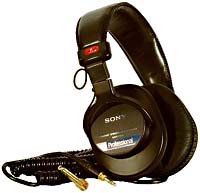Dream Sequence 6
Phase two: My gear continued
Cables and adapters are a world in themselves. A good cable lets a microphone sound noticeably better than a bad one. And adapting anything down to the mini jack of a consumer camera can be a nightmare of flimsy connections. I found it very worthwhile to go to a pro audio shop and have somebody make me great cables with reliable connectors (Switchcraft or Nuetrik) that go directly from the mic to the camera without adapters. Whenever possible, I try to use right-angle plugs that don't stick out.
 |
Among the most important considerations on a documentary shoot are batteries and a way to charge them. Charging batteries on location in the middle of nowhere has a way of taking over your entire existence. I constantly check their status. I usually try to have twice the battery power I think I'll need wherever I go. As I'm usually camped near my car, I try to charge batteries using a special charger that plugs into the cigarette lighter, and it's pretty much always charging something. Therefore, I also keep some jumper cables around, for the inevitable day I actually try to start the car and go someplace.
There are an infinite number of helpful little items in addition to these tools that I've learned to carry with me in the field. My camera-cleaning kit contains cans of air, a very soft brush, lens-cleaning tissue and fluid, a microfiber polishing cloth, and a head-cleaning cassette, which I use extremely infrequently to save wear on the head. I have Velcro cable ties, a few spring clamps, and white and black gaffer's tape of various widths. I try to have two of every kind of cable in case one goes blooey, and I even pack tiny screwdrivers, needle-nose pliers, superglue, and a small soldering kit in the event that I'm really screwed and need to perform surgery on something (it happens). And a new item I've found really handy is a set of headlamps that are like eyeglass frames with a tiny flashlight on either side. When you're hunting for things in the dark, or for buttons on the side of your camera, headlamps are a joy, and they're about $8 at a hardware store.
Last but far from least was my choice of luggage. Don't laugh - any world traveler will back me up on this. It becomes vital to know how to organize all this gear and get at what you need when you need it, protect it from the violence of the world, and carry it all by yourself when you need to. I have a great camera bag that holds the immediate gear I mostly use, with a little extra room for accessories and extra batteries. It's well padded, and the inside can be partitioned with Velcro-attachable dividers. These kinds of bags are available at most pro camera shops, and I'm considering getting one that can be carried like a backpack. In addition, I have a large (42" x 12" x 12") padded bag for things like my tripod, microphone stand, light stands, and umbrellas (if I use them), and such long things. Then I have a few smaller bags that contain microphones, cables, batteries, tools, and all the rest. Here's a helpful hint: Tupperware-type containers make great organizers for small objects. Before I go out on location, I spread everything I think I might possibly need out on the living-room floor and organize it into my bags. The system you use to carry all this stuff can mean the difference between getting your shot and missing it.
I have to say that shooting a documentary is like a sport. When the moment is in front of you, there is no substitute for knowing how to shoot and knowing your equipment. After you get any piece of gear, you should take it out into many environments and spend enough time with it to learn how and when to use it, and when it's just going to get in the way. Also, remember that a person who knows what he or she is doing can perform miracles with the most terrible, outdated equipment. Before you start shooting, learn your craft.